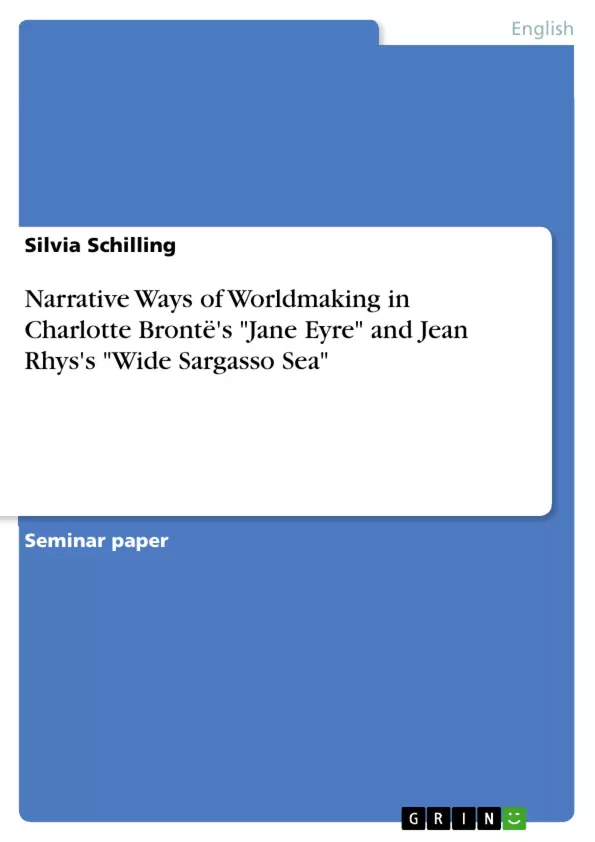Within this paper, the "worldmaking" of Charlotte Brontë's "Jane Eyre" (1847) and Jean Rhys's "Wide Sargasso Sea" (1966) is compared. This is especially fruitful because the fictional worlds of these novels are connected: In "Jane Eyre", Mr. Rochester has a hidden wife called Bertha Mason. Wide Sargasso Sea casts this character as its protagonist and covers her journey from childhood into adulthood, when she becomes a part of Jane Eyre's world. After an introduction of Nelson Goodman´s term "worldmaking" and several of its characteristics, the worlds of these two novels are compared, focusing specifically on the respective selection of characters, perspectivization and the semantization of space.
Inhaltsverzeichnis (Table of Contents)
- Introduction
- Narrative Ways of Worldmaking: A Selection
- The Worlds of Jane Eyre and Wide Sargasso Sea
- Selection of Characters
- Jane Eyre and Antoinette Cosway
- Brontë's Rochester and Rhys's Edward
- Perspectivization: “There is always the other side, always” (Rhys 81)
- Semantization of Space
- Selection of Characters
Zielsetzung und Themenschwerpunkte (Objectives and Key Themes)
This paper examines the construction of fictional worlds in Charlotte Brontë's Jane Eyre and Jean Rhys's Wide Sargasso Sea. It explores how the choice of characters, perspective, and narrative space shapes the worlds depicted in both novels. The paper investigates how these worldmaking processes contribute to the distinct interpretations of the same events and characters, particularly focusing on the figure of Bertha Mason/Antoinette Cosway.
- Narrative worldmaking and its impact on the construction of fictional worlds
- The role of character selection in shaping a narrative world
- The influence of perspective on the interpretation of events and characters
- The semantization of space and its connection to character, perspective, and meaning
- The relationship between Jane Eyre and Wide Sargasso Sea, particularly in their portrayals of Bertha Mason/Antoinette Cosway
Zusammenfassung der Kapitel (Chapter Summaries)
The first chapter introduces the concept of "ways of worldmaking" as theorized by Nelson Goodman, focusing on how these processes are applied to narrative. This chapter highlights the importance of deformation, weighting, ordering, and perspectivization in understanding the construction of fictional worlds. The second chapter delves into the worlds of Jane Eyre and Wide Sargasso Sea, exploring the specific ways in which character selection, perspective, and space shape these narratives. The chapter examines how these worldmaking processes are utilized to present contrasting interpretations of the same events and characters, highlighting the distinct perspectives offered by both novels.
Schlüsselwörter (Keywords)
This paper delves into the key themes of narrative worldmaking, character selection, perspective, space, and the relationship between Jane Eyre and Wide Sargasso Sea, particularly in their portrayals of Bertha Mason/Antoinette Cosway. It investigates how these elements contribute to the distinct interpretations of the same events and characters, highlighting the contrasting perspectives presented by both novels.
- Citar trabajo
- Silvia Schilling (Autor), 2018, Narrative Ways of Worldmaking in Charlotte Brontë's "Jane Eyre" and Jean Rhys's "Wide Sargasso Sea", Múnich, GRIN Verlag, https://www.grin.com/document/520759



